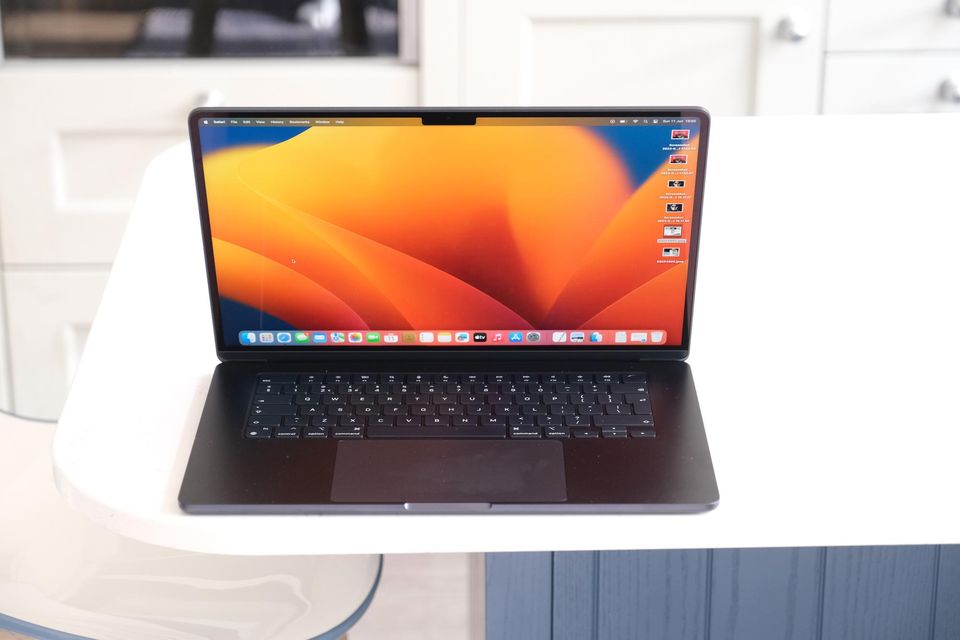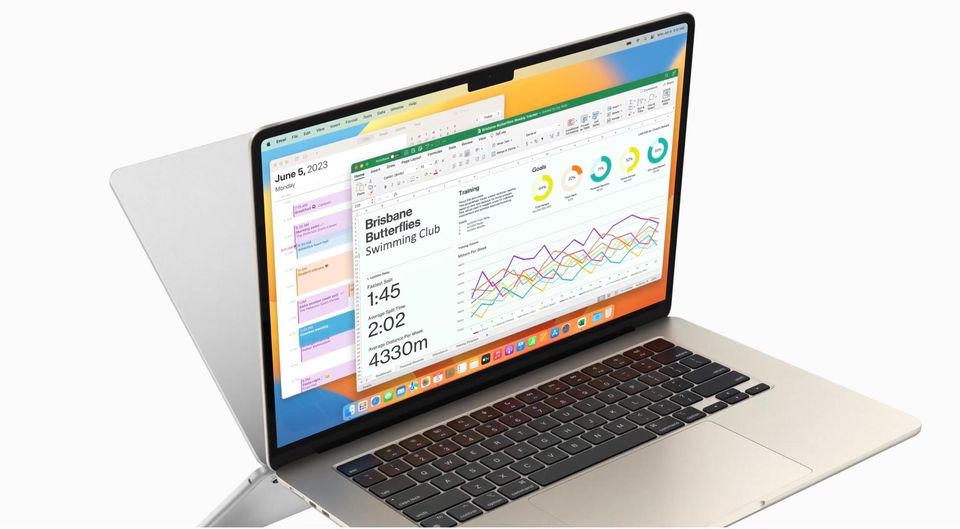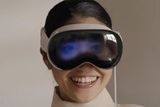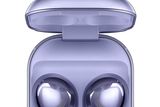MacBook Air M2 15-inch review: the best laptop you can buy under €2,000
Apple’s first large-screen MacBook Air is basically the same laptop as the 13.6-inch version released last summer. But with a screen that’s 25pc bigger and a few other minor tweaks, it’s a no-brainer for many new laptop buyers.
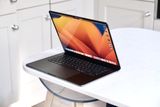
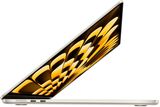
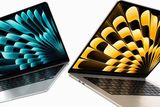
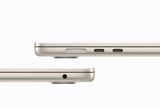


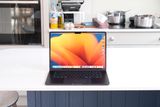
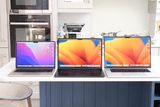
The new 15.3-inch MacBook Air M2 is a no-brainer for someone who wants a larger-screen MacBook but doesn’t need all the graphics-focused bells and whistles of a Pro machine. It’s the best 15-inch laptop you can buy for under €2,000.
….
MacBook Air M2, 15-inch
Price: from €1,649 (256GB, 8GB)
Screen: 15.3 inches (25pc bigger than 13.6-inch MacBook Air M2)
Engine: M2 chip, 8GB-24GB Ram, 10-core GPU
Colours: Midnight, Starlight, Space Grey, Silver
Battery: 18 hours
Ports: MagSafe, 2 USB-C, 3.5mm headphones
MacBook Air M2 15-inch. Photo: Adrian Weckler
This is basically the same laptop as the 13.6-inch M2 version launched last summer, except with a bigger screen and one or two minor tweaks. That means that it has very long battery life and is relatively powerful, with a price that’s €850 cheaper than the M2 MacBook Pros. I’ve been testing it for a few days, comparing it to the 13.6-inch MacBook Air M2 that I bought last year.
….
1. Differences between 13-inch and and 15-inch models
There are very few, except for the size of the display and, consequently, the weight. The new model has the same screen resolution, keyboard, ports, colours, exterior finish and almost the exact same engine. There are only four minor differences that I could spot.
(i) Slightly faster GPU on entry-level version: this won’t affect many typical MacBook Air buyers, but the entry-level 15-inch model has a 10-core GPU compared to the 13-inch version’s 8-core GPU. That’s a minor advantage for heavy-duty tasks.
(ii) Slightly better speaker audio: the 15-inch model has two extra physical speakers. I can definitely hear the difference when I put both models side by side: the 15-inch one is better. (However, it’s still a solid step down from the MacBook Pro models, which have far better audio speakers.)
(iii) Slightly higher screen ratio: the 15-inch model has the same size bezels (5mm) and notch as the 13-inch model. But because the 15-inch model is already bigger, that means that the percentage of screen you’re getting, relative to the impact the bezels make, is actually greater.
(iv) Slightly faster charging: the entry-level 13-inch model comes with a basic 30-watt charging adapter, while all versions of the 15-inch model come with the choice of either a 35-watt dual-USB-C charging adapter (an adapter with two USB-C ports on the back) or a much faster 70-watt adapter.
Side by side comparison: MacBook Air M2 13-inch, MacBook Air M2 15-inch, MacBook Air M2 Pro 16-inch. Photo: Adrian Weckler
2. Battery life
Since Apple launched its M1 processors, battery life has arguably been the biggest improvement for ordinary users. The 15.3-inch model has the same battery life as the 13.6-inch version, at up to 18 hours per charge. In reality, for me, I never had to recharge it during the day, no matter what I was doing for work. I didn’t get less than 10 hours’ use of it at any stage, even when I sometimes used it outside in sunny conditions (where the screen needed to be at maximum brightness).
3. Display
The 15.3-inch ‘Liquid Retina’ display is the same, technically, as the 13.6-inch model. It’s not as bright or as vivid as the MacBook Pro M2 screens but it compares reasonably well with other brands’ laptops priced around the same. It’s noticeably brighter than the M1 MacBook Air. I find that it’s great, overall, for regular work tasks and fine for movies. Technically, it’s a 2560x1664, wide colour (P3) screen with Apple’s ‘True Tone’ technology and 500 nits of brightness.
MacBook Air M2 15
4. Engine
My test model came with 16GB of Ram, which bumps the price up €230. I’d question whether most people need that extra memory, though. The M2 MacBook Air I bought has just 8GB of Ram and I’ve never once found it lagging or being anything other than quick, even when I’ve done some (light) video editing. Mostly, the reason for this is Apple’s M2 chip and its general engine architecture. The M2 chip is fantastically powerful and efficient compared to Intel chips, taking some of the burden away from the requirement to have more Ram. You can configure the MacBook Air with up to 24GB of Ram, but I’m struggling to imagine what kind of MacBook Air user needs this kind of memory under the hood. For sure, this machine can be used for heavier tasks such as coding, graphics or video editing. But people who really need to do this are generally better off getting an M2 (or even M1) MacBook Pro, which will do it quicker and can handle longer, more sustained tasks.
One last point to note is that the M2 MacBook Air has no fan, which makes it quieter than the MacBook Pro M2 (at the point when it needs to rely on its fan).
5. Ports
Like the 13.6-inch model, this M2 MacBook Air comes with a MagSafe charging port, two USB-C ports (both of which can be used for charging, too) and a 3.5mm headphone port. In general, I find that this is enough for the vast majority of connection cases. I do sometimes need to upload and edit photos and videos, but I simply used a small card adapter for that.
The MacBook Air M2 has a MagSafe charging port, two USB-C ports and a 3.5mm headphone port
6. Charging
The MacBook Air M2 charges pretty quickly, but the 15-inch model gives you slightly faster options as standard. It comes with your choice of a 35-watt dual USB-C charging adapter (an adapter with two USB-C ports on the back) or a faster 70-watt adapter. Both of these options are available with the 13.6-inch model, but you have to either pay extra (€20) or buy a higher spec model (512GB and 10-core GPU) or you’ll just get the standard 30-watt charging adapter.
7. Design and keyboard
Alongside battery and engine power, this is a high point. The MacBook Air looks great and is fairly effortless to use. Its excellent ‘Magic’ keyboard is pretty hard-wearing and easy to type on. It’s the thinnest laptop you can get at this size and is close to the lightest. That makes it noticeably easier to bring around than other large-screen laptops. The aesthetic finish on the 15-inch model is exactly the same as the 13-inch model, including the colour options, which are grey, silver, ‘midnight’ (black) and ‘starlight’ (light grey and gold). When I went to buy one, I chose ‘Starlight’, a decision I stand over: it’s ageing very well. By contrast, my test model for the 15-inch version was ‘midnight’. While this is arguably the most striking of the four colour options, it is quite the fingerprint magnet. Within 30 seconds of unboxing it, there were prints on the rear casing and the areas around the keyboard.
MacBook Air M2 15. Photo: Adrian Weckler
8. Other things
(i) Audio speakers: as mentioned above, the 15-inch model adds an extra couple of speakers to the laptop, which is noticeable. In general, the MacBook Air also supports ‘spatial audio’ when you’re using newer AirPods. This is a nice touch.
(ii) Webcam and mics: the 1080p FaceTime HD camera on both this 15-inch MacBook Air M2 and the 13-inch version is generally good. It’s far better than the outdated 720p version on the M1 MacBook Air or the 13-inch M2 MacBook Pro. Combined with the three-microphone array, this setup, I have found, is excellent for things like conference calls. I’ve also used this for live TV links and it’s completely fine.
(iii) Pricing: the 15.3-inch MacBook Air M2 starts at €1,649 (256GB, 8GB) and maxes out at €3,029 (2TB, 24GB).
MacBook Air M2 15
9. Is this just as good as an M2 MacBook Pro?
Not quite. I have an M2 MacBook Pro and even for my non-engineering, non-graphics use, it still excels on one or two levels. That main one is the screen. As thoroughly decent as the MacBook Air’s display is, the Pro’s is noticeably better, especially in bright conditions or when sitting beside a window.
The audio speakers are also discernibly better on the Pro than on the Air. And, of course. It has way more slots and ports. This is handy not only for things like memory cards, but also for occasional stuff connecting to things like older presenting projectors. It’s just a better, more capable, higher-spec all-round machine.
10. 15-inch versus 13-inch: weighing up the choice
Why you’d get the 15.3-inch version
(i) The bigger screen really is significantly bigger – about 25pc more display to play with. That means lots more room for multiple windows. It also means the luxury of larger fonts for those who struggle with the default 10 or 11-point fonts on many applications.
(ii) If you need that bigger screen, it’s €850 less than the cheapest MacBook Pro (which has a smaller 14-inch display; it’s €1,450 less than the cheapest 16-inch MacBook Pro).
(iii) It has slightly better audio speakers, slightly faster graphics performance (at entry level) and slightly faster charging than the 13.6-inch model.
(iv) It’s thinner and lighter than almost every other 15-inch laptop from any other brand.
Why you’d get the 13.6-inch version
(i) It’s thinner, lighter and more compact than the larger model. This makes it easier to fit into bags and travel around.
(ii) It just got a €180 price cut (from €1,529 to €1,349). So it’s €300 cheaper than the 15.3-inch model for almost the exact same specifications, bar the larger screen. It’s also less than €150 more than the M1 model of three years ago, which is still on sale but which has significantly lesser specifications.





